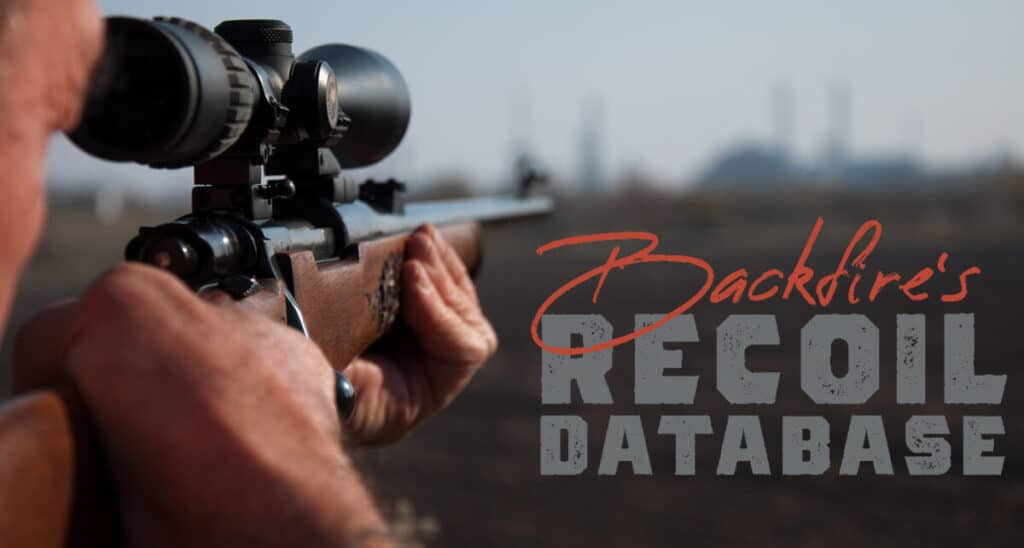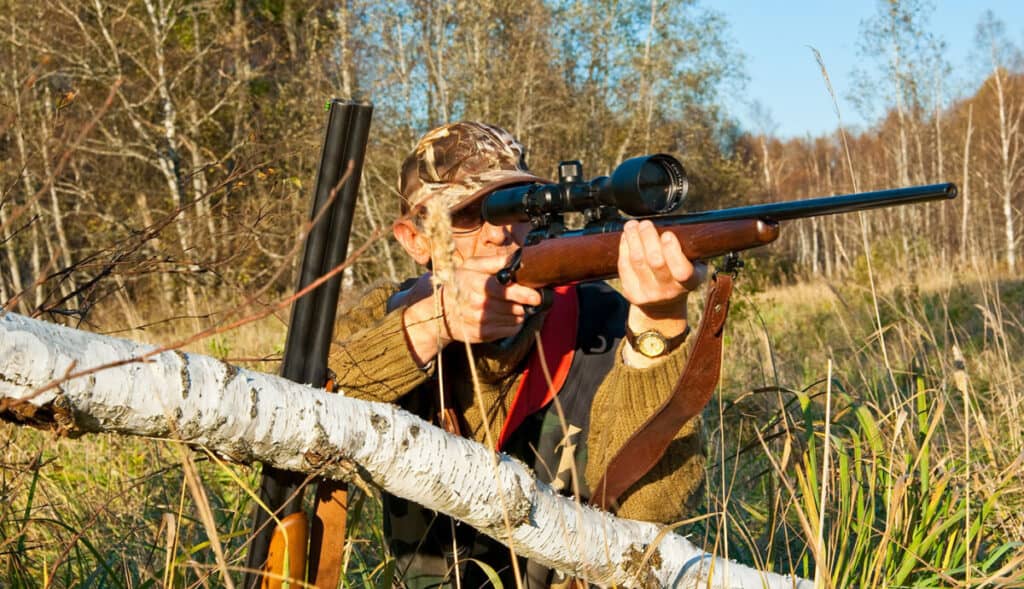
I have spent literally hundreds of hours collecting the information in this blog post. I created it because other recoil databases I found online are dated and do not have the depth of research to truly compare cartridges apples-to-apples.
For those of you who are new to firearms, let’s discuss the basics of what recoil is before we look at the data.
Recoil is the force of a gun pushing back against the shooter when a bullet is fired. It is commonly called a gun’s “kick.” More recoil is created when more powerful powder loads and lighter-weight firearms are used. Recoil is measured by free recoil energy, and recoil velocity.
Selecting a rifle and cartridge combination which does not produce too much recoil for the shooters is critical to being able to shoot accurately without developing a flinch.
A Quick Guide to Understanding Free Recoil Energy
- Over 30 ft-lbs – Massive recoil that can be difficult for even seasoned shooters to shoot accurately.
- Over 25 ft-lbs – In a lightweight rifle, even experienced shooters can struggle to shoot more than 15 rounds without pain or developing a flinch, UNLESS a muzzle brake, suppressor, or heavier rifle is used.
- Over 15 ft-lbs – Begins to be very difficult to spot the bullet impact on target through the scope because of the recoil.
- Under 10 ft-lbs – Even newer shooters can easily spot impacts through the scope during recoil. Ideal for youth shooters.
- Under 4 ft-lbs – Feels more like a vibration than a “push.”
Keep in mind that attaching a muzzle brake reduces the free recoil energy by about 40% and attaching a suppressor reduces free recoil energy by about 32%. As you read through the table, remember you can pick a much heavier-hitting cartridge if you’ll be using a muzzle device. I do NOT recommend muzzle brakes for youth shooters because the loudness scares them more than the recoil-even with hearing protection on.
Without further ado, I give you… the rifle recoil database!
.
How Rifle Recoil is Calculated
The formula for determining the free recoil energy of a firearm is (Rifle Weight in Pounds/64.34) *(Recoil Velocity in FPS^2). This formula relies on the formula for recoil velocity, which is simply (Bullet Weight In Grains * Muzzle Velocity in FPS + Powder Charge in Grains * Muzzle Velocity * 1.75)/(7000 * Rifle Weight in Pounds).
The trouble with this formula is that most people don’t know the powder charge unless they hand load their own ammunition, and all of the other number depend on several factors. This makes it tough to figure out the recoil of a rifle unless you look up a lot of other information first.
After shooting a lot of different rifles and cartridges, I have found that recoil velocity number accurately predicts how much pain you’ll feel, and the recoil energy predicts how much you’ll get rocked back and thrown off your target in the scope. Why? I’ll explain.
Suppose a giant, heavy semi-truck is parked in front of you with your shoulder on the bumper. Now that truck creeps forward and pushes your shoulder at a speed of 2 inches per second. Because it’s giant and heavy, it’s going to move you significantly, but it won’t really hurt at all since it’s moving slowly.
Instead, imagine a baseball traveling at 25 inches per second that hits your shoulder. It would hurt much more than the semi-truck.
The same is true with guns. Some people look at the recoil energy of a 50BMG and think they will be KILLED by 83.17 ft-lbs of free recoil energy; however, the 50BMG is a physically heavy gun (usually over 30 lbs), so the recoil moves slowly (also because of the muzzle brake). People who have actually shot a .50BMG usually report mild recoil similar to a .308 Winchester. The recoil VELOCITY number of the .50 BMG is similar to a .308. Just recognize that it’s going to push you a lot-even though it won’t be painful.
About Backfire’s Rifle Recoil Table: How we perform calculations
- Analyze over a dozen models of rifles chambered in each cartridge to determine the average rifle weight to put in the formula. If you’re shooting a particularly light or heavy firearm, you’ll need to do a separate calculation, but this will be a fair comparison of what the rifle weight normally is. Most recoil tables simply use a 9 lbs firearm for all calculations, but this leads to crazy results for the lightweight 22lr and the heavyweight 50BMG. Also, we include scope and other common accessories to get a realistic field rifle weight.
- Normalize powder charges within each caliber to make a fair comparison. You can load a 7 Rem Mag with Retumbo or H4350, but the amounts will be different. We keep powder charges consistent to reality within each caliber of firearm.
- Average over 6 common loads for each cartridge to determine realistic muzzle velocities to include in the formula. Most recoil tables take the muzzle velocity on the box at face value, but we all know that’s rarely accurate-especially if you shoot a shorter barrel length. If you see our recoil numbers are usually just a little less than what you see elsewhere on the web, it’s likely because we’re using more precise averages of muzzle velocities across a variety of common loads for each cartridge.
- Consider multiple loads for each cartridge to determine a fair average of bullet weights for that cartridge, and caliber.
Lightest Recoiling Firearms for Deer and Elk Hunting
After surveying the Backfire audience, we found that 96% of shots on big game are taken within 500 yards. So in the below table, we look at the rifles and their recoil sorted by recoil velocity (the pain it will inflict) from most to least.
Then, look in the three right columns to make sure it has enough power to kill the animal you’re hunting. For deer-sized game, it is recommended that you have at least 1,000 ft-lbs of energy, a Hornady HITS formula ranking of at least 500, and at least 1,900 fps of velocity.
For elk-sized game, it is recommended that you have at least 1,500 ft-lbs of energy, a Hornady HITS score of at least 900, and at least 1,900 fps of velocity.
Same Table As Above, But Now at 300 Yards
How Much Recoil Is Too Much Recoil?
Just seeing a list of recoil numbers is helpful, but it can still be difficult to know what that feels like in reality. Hopefully, the following comparison of some of the most popular cartridges today will be helpful.
In general, most large-bodied and experienced adult shooters can comfortably shoot a rifle with a recoil velocity of under 13.5 fps without developing a flinch. Many smaller-bodied or inexperienced adult shooters begin to experience flinch at approximately 11.75 fps of recoil velocity.
- The.243 Winchester’s recoil produces 9.22 ft-lbs of energy at a recoil velocity of 8.48 fps. That amount of recoil is low enough that even youth shooters have no problem shooting the cartridge. It feels more like a sudden vibration than actual kick.
- The 6.5 Creedmoor produces 11.83 ft-lbs of energy at a recoil velocity of 9.54 fps in an average-weight rifle. It is considered to have very mild recoil, which many youth shooters and all adult shooters can generally shoot without any flinch or pain.
- The 6.5 PRC generates 16.27 ft-lbs of energy at a recoil velocity of 11.19 fps. Its recoil is noticeable, but most adult shooters consider it sufficiently mild as to not require a muzzle break or suppressor. It has very similar recoil to the 7mm-08, and slightly less than the .270 Winchester.
- The .270 Winchester’s recoil produces 17.64 ft-lbs of energy and 11.64 fps of recoil velocity. Most people consider the .270 a moderate-recoiling cartridge that can push the shooter off target during the shot, but is not enough to cause pain in the average adult shooter.
- The 7mm-08 Remington’s recoil produces 14.88 ft-lbs of energy at a velocity of 10.68 fps. Because of its mild recoil, it is often recommended as a good hunting cartridge for youth and small-framed shooters.
- The 7mm Remington Mag generates significant recoil of 22.15 ft-lbs at 13.32 fps. Smaller-framed or young shooters generally consider the cartridge as having high recoil, but its recoil is manageable for experienced large-framed shooters to be able to shoot it regularly.
- The .28 Nosler produces a sharp, powerful recoil which most shooters find to be too much unless they shoot with a muzzle break or suppressor. It produces 28.27 ft-lbs of recoil energy at a velocity of 14.72 fps. Because of its recoil, a .28 Nosler should generally only be shot out of heavier rifles, coupled with a brake or suppressor.
- The .30-06 cartridge has a strong but not particularly sharp recoil. It generates 21.34 ft-lbs of energy at 12.55 fps. In a well-designed rifle and stock, the .30-06 recoil is acceptable for most adult shooters, but in many older rifles with poorly-designed stocks, the recoil can feel too powerful.
- The .50BMG produces a tremendous amount of recoil, measuring at 83.17 ft-lbs of energy. Although the recoil energy is significant, it moves relatively slow at 11.91 fps. Additionally, the .50 BMG is almost always shot with a massive muzzle brake which can reduce the recoil by 50%.

Reducing the Recoil of Your Rifle
I have tried many different methods for reducing the recoil of cartridges that are too powerful. The most common method that shooters choose is to simply add a muzzle brake. This can reduce the recoil between 20% and 50% depending on the size and effectiveness of the brake. Personally, I hate muzzle brakes and don’t use them at all anymore.
The problem with muzzle brakes is that they increase the volume of the gunshot significantly. Even with foam earplugs or earmuffs, the sound can still be loud enough to make ears ring. When I shoot muzzle brakes, I use both earplugs as well as muffs in order to protect my hearing.
Muzzle brakes come in two basic varieties: radial port and side-port. A radial-port brake has holes all around the sides which can make it more effective, but sends out a blast of dust when shot near the ground because it blasts down and not just to the sides.
My preferred method for reducing recoil is using a silencer (suppressor, if you will). A silencer can reduce a firearm’s recoil up to 45% while also making the gunshot quieter. While I still use hearing protection with a silencer, it makes the sound more tolerable.
An additional method to reduce the recoil of a firearm is to use “downloaded” rounds. Handloaders can simply put less powder in the cartridge, but even those who purchase factory ammunition can often find “reduced recoil” loads which can reduce the recoil by approximately 10%.









